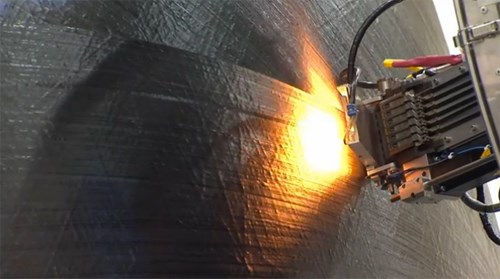Carbon fiber cryotank angles for a place in launch systems
Boeing has manufactured two carbon fiber cryotanks that are being evaluated by NASA for use in heavy-lift launch systems. They offer 30 weight and 25 percent costs savings.

Automated fiber placement (AFP) was used by Boeing to build two carbon fiber cryotanks, which are being evaluated by NASA for use in heavy-lift launch systems. The tanks offer substantial weight and cost savings compared to metallic competitors.
Boeing is working on development of a carbon fiber composite liquid-hydrogen fuel tank for heavy-lift launch vehicles and other spacecraft. Under contract with NASA’s Space Technology Game Changing Development Program, Boeing has designed and built two such tanks.
Final assembly of the larger (5.5/18-ft) tank has been completed at the Boeing Developmental Center in Tukwila, Wash., USA, and transported to NASA’s Marshall Space Flight Center in Huntsville, Ala., USA for testing. This follows Boeing and NASA successfully testing a 2.4m/7.9-ft composite tank at Marshall last year. The tanks promise a 30 percent weight reduction and 25 percent cost savings compared to state-of-the-art metallic tanks used today.
Dan Rivera, the cryotank program manager within Boeing Research & Technology, the company's advanced R&D organization, said Boeing and NASA’s innovation provides weight and cost savings in a combination that's hard to find. “We used new composite materials and an integral design capable of withstanding launch vehicle loads,” Rivera says. “Boeing and NASA have assembled some of the world’s experts for this project. The approaches and technology they used in the design and fabrication of these tanks is revolutionary and is a major step toward providing greater capability to future space exploration.”
Aside from designing a lighter tank that can withstand extreme pressurization and the stress rockets endure during flight, engineers also had to figure out the best way to store cryogenic (super cold) liquid hydrogen, which is one of the most efficient rocket fuels. The hydrogen molecule can penetrate through traditional composites when temperatures get cold and the composite is loaded.
To combat microscopic leaks, Boeing engineers manufactured the cryotanks with automated fiber placement (AFP) machinery to lay thinner plies. By building two different-sized cryotanks, Boeing and NASA can test and validate the structures and technologies. Successful tests could potentially lead to the use of these types of composite cryotanks on heavy-lift vehicles, in space propellant depots and other Earth-departure exploration architectures.
According to NASA, a potential initial target application for the composite technology is an upgrade to the upper stage of NASA's Space Launch System, a new heavylift rocket meant for deep space travel.
Related Content
-
Plant tour: Albany Engineered Composites, Rochester, N.H., U.S.
Efficient, high-quality, well-controlled composites manufacturing at volume is the mantra for this 3D weaving specialist.
-
Welding is not bonding
Discussion of the issues in our understanding of thermoplastic composite welded structures and certification of the latest materials and welding technologies for future airframes.
-
PEEK vs. PEKK vs. PAEK and continuous compression molding
Suppliers of thermoplastics and carbon fiber chime in regarding PEEK vs. PEKK, and now PAEK, as well as in-situ consolidation — the supply chain for thermoplastic tape composites continues to evolve.















.jpg;maxWidth=300;quality=90)
